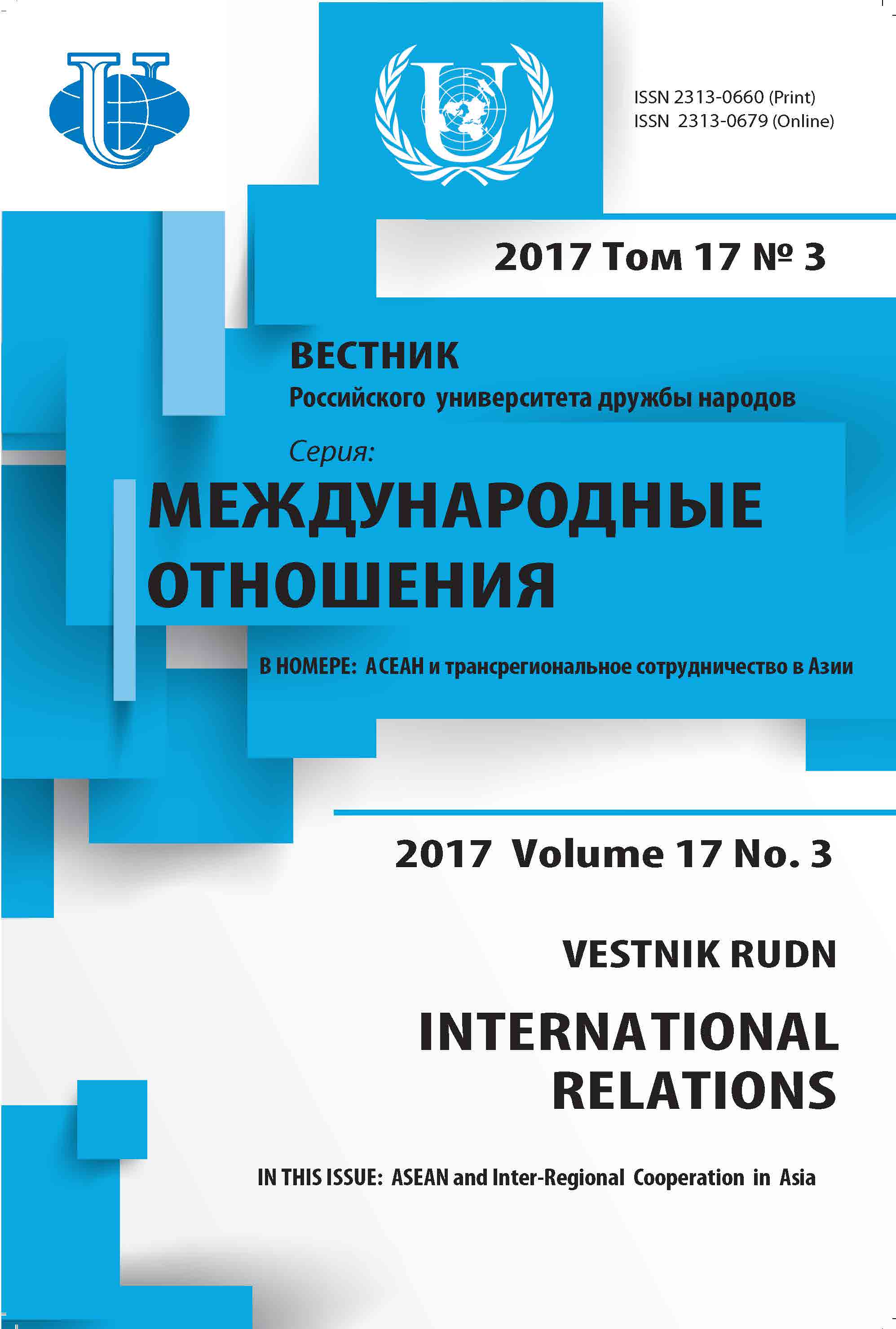THE TAIWAN QUESTION: EXTERNAL AND INTERNAL DETERMINANTS
- Authors: Lychagin AI1, Komarov ID1
-
Affiliations:
- Lobachevsky State University of Nizhny Novgorod, Nizhny Novgorod, Russia
- Issue: Vol 17, No 3 (2017): ASEAN and Inter-Regional Cooperation in Asia
- Pages: 530-538
- Section: PEACE AND SECURITY
- URL: https://journals.rudn.ru/international-relations/article/view/16765
- DOI: https://doi.org/10.22363/2313-0660-2017-17-3-530-538
- ID: 16765
Cite item
Full Text
Abstract
The article is devoted to peculiarities of the Taiwan question, given a special position of the island in the modern system of regional and international relations. The specificity of the relations between the two shores of the Taiwan Strait, the domestic political struggle, a unique position in the regional system of Southeast Asia, regional and transregional integration processes provide a model for well-balanced interaction. Constant vector of the PRC's policy towards the island, the formation of a new paradigm of Taiwan’s “viable diplomacy”, the change of investment flows of USA to Taiwan in periods of ruling of Kuomintang and DPP - distance the prospect of a military solution to the issue of the two shores. The difficulty faced by one or the other leading party of Taiwan is determined by the structural dif-ferences in their programs relative (a key parameter) to mainland China. In the twenty-first century PRC demonstrates the high efficiency of economic instruments for reintegration. In addition to the restrictions, from the point of view of convergence of opposite sides, and, given the long-term prospects, most acceptable is the creation of preferential terms of trade and economic cooperation. This model is applicable by Beijing at the regional and transregional levels. The authors conclude that Taiwan's economy closely connected with mainland China complements the civilizational message of the unity of the Han and their right to civilizational dominance in Southeast Asia and the Asia-Pacific region.
About the authors
A I Lychagin
Lobachevsky State University of Nizhny Novgorod, Nizhny Novgorod, Russia
Author for correspondence.
Email: kaf.vostok@mail.ru
Doctor of History, Professor, Head of the Department of Oriental Languages and Linguoculturology of Institute of International Relations and World History of Lobachevsky State University of Nizhny Novgorod
I D Komarov
Lobachevsky State University of Nizhny Novgorod, Nizhny Novgorod, Russia
Email: igor.komarof@gmail.com
applicant of the Kazan (Privolzhsky) Federal University, engineerlaboratory assistant of the Center for Expertise and Comprehensive Analysis of the Institute of International Relations and World History of the Lobachevsky State University of Nizhny Novgorod, deputy director of the Institute of International Relations and World History of Lobachevsky State University of Nizhny Novgorod
References
- Balakin, V.I. (2013). Taiwan in the system of East Asian integration China. In: China in world and regional politics. History and the present. Vol. XVIII. Moscow: IFES RAS, p. 223—231. (in Russ.).
- Bush, R. (2015). Taiwan’s January 2016 Elections and Their Implications for Relations with China and the United States. The Brookings Institution, Asia Working Group. Paper 1. URL: https://www.brookings.edu/wp-content/uploads/2016/07/taiwan-elections-china-us-implications-bush-FINAL-2.pdf (accessed: 12.05.2017).
- Chai, W. (2008). Taiwan's 2008 Elections and Their Impact on U.S.-China-Taiwan Relations. Asian Affairs, 35 (02), 83—92. DOI: http://dx.doi.org/10.3200/AAFS.35.2.83-94.
- Larin, A.G. (2012). Cooperation of the Taiwan Straits: progress, problems, prospects. The Far Eastern Affairs, 4, 13—26. (in Russ.).
- Malyavin, V.V. & Chen, Jiawei (2012). The democratic progressive party and the political system in Taiwan. The Far Eastern Affairs, 6, 118—129. (in Russ.).
- Mikheev, V. (2001). Mainland China — Taiwan relations in the light of globalization. The Challenges of globalization in Taiwan: Scientific. Conf. December 8, 2000; Moscow: Pamyatniki isto¬richeskoi mysli, p. 20—30.
- Morrison, W.M. & Kan, S.A. (2014). U.S.-Taiwan Relationship: Overview of Policy Issues. Congressional Research Service Report. URL: https://fas.org/sgp/crs/row/R41952.pdf (accessed: 12.05.2017).
- Salitskii, A.I. (2003). China — Taiwan: prospects for economic integration. Modernization of Taiwan and the prospects of relations with PRC: Materials of Scientific Conf. IMEMO; Moscow: IMEMO of RAS, p. 49—53. (in Russ.).
- Saunders, P.C. (2005). Long-term Trends in China-Taiwan Relations: Implications for U.S. Taiwan Policy. Asian Survey, 45 (06), 970—991. doi: 10.1525/as.2005.45.6.970.
- Trifonov, V.I. (2010). Beijing to Taipei: prospects for dialogue. Modern Taiwan: the informational-analytical materials, 11 (19), 38—54. (in Russ.).
- Vasil'ev, L.E. (2012). Southeast Asia: the United States and China — from rivalry to confrontation. In: China in world and regional politics. History and the present. Vol. XVII. Moscow: Institute of far Eastern studies RAS, p. 87—99. (in Russ.).
- Verchenko, A.L. (2010). The return of the Kuomintang: some results. Contemporary Taiwan, 11 (19), 24—37. (in Russ.).
- Verchenko, A.L. (2014). The Fourth generation of the CPC leadership: relations across the Taiwan Straits and the position of Russia. Society and state in China: XLIV Scientific. Conf. Part 1; Moscow: IOS of RAS, p. 281—291. (in Russ.).
- Wu, J. S.-Y. (2009). Economics, Lobbying, and U.S. Congressional Support for Taiwan: Buying American Support, 2002—2006. Asian Survey, 49 (02), 380—402. doi: 10.1525/as.2009.49.2.380.
Supplementary files










